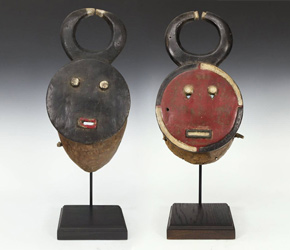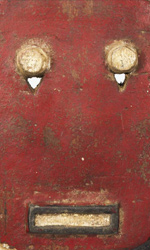Baule Kple Kple Masks
 |
|
| Pair of Kple Kple masks from the Baule people of the Ivory Coast, West Africa |
It Takes Two to Tango
Is anything more universal than dance? It seems to be part of just about every culture the world has ever known. In the west, it’s an inherent part of weddings and balls; and in many cases our own home life. Who hasn’t danced alone to the beat of a favorite song or been prompted and prodded to get up and dance by a partner or friend? Yet, go to sub-Saharan Africa and you’ll find dance is so deeply ingrained into village life there is barely an activity not associated with some sort of body movement. In fact, just about every tribe seems to have at least one particular dance to help define their identity and beliefs.
 |
|
| The red Kple Kple mask is considered female and the black, male |
This week’s New Arrival features a pair of dance masks from the Baule people in the Ivory Coast of West Africa. Sometimes called “moon masks” even though they represent the life giving sun, they are formally known as Kple Kple masks, the name of the spirit they also depict. An integral part of a daylong celebration called the Goli, the red mask is considered female and the black, male. Imagine these masks as they were used in the Goli spirit dance. Worn by young men who stomped in rapid, highly expressive movements to lively music, the masks helped celebrate peace, joy, lives well-lived, the harvest – and, of course, dance itself.
View Red Mask ›› View Black Mask ››
 |